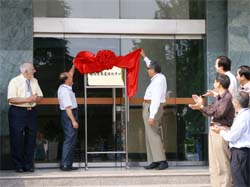

On suburban Hefei's "Science Island", one of China's key thermonuclear fusion research and experiment bases, a research center has been officially launched to study the magnetic confinement of plasma and related theories.
Based on the Experimental Advanced Superconducting Tokamak (EAST) successfully developed in 2006 by the CAS Institute of Plasma (IoP), the newly-established center aims at promoting the research and development of nuclear fusion science and technology, improving the advanced steady-state operation mode of Tokamak, upgrading experimental facilities in this regard, and starting a physical and engineering buildup for the eventual development of a commercialized nuclear reactor.
It will carry out studies in light of China's strategy for the development of magnetic confinement of nuclear fusion by a combination of theoretical and technological studies. It endeavors to boost domestic and international cooperation as well as talent training in relevant fields.
Upon its opening ceremony held on 2 September, the nameplate of the new research hub was jointly unveiled by Prof. LI Ding, director-general of the CAS Bureau of Basic Research and the center's honorary director Prof. LIU Chuan Sheng with the Department of Physics, University of Maryland.
The ceremony was chaired by Prof. LI Jiangang, head of the IoP and vice-director of the Hefei-based CAS Institutes of Physical Science. Also present were scholars from Princeton Plasma Physics Laboratory, General Atomics Fusion Energy Research, Lawrence Livermore National Laboratory and the Max Planck Institute for Plasma Physics.
According to experts, controlled nuclear fusion presents one of the most challenging yet compelling tasks for today's scientists. In the process of fusion, light atomic nuclei (such as hydrogen) join together to form heavier ones (such as helium), and at the same time release enormous energy which is considered infinite, safe, clean, and ideal for the Earth – a planet about to run out of its fossil fuels. However, the reaction conditions are extremely demanding: a temperature of tens of millions of degrees, sufficient plasma density and energy confinement among others.
As for the confinement of the plasma, in the 1960s, Russian scientists came up with a doughnut-shaped chamber with which they caged the hot gas with magnetic fields. They called the device Tokamak. Since then, countries such as Russia, France, Japan and China have based their nuclear fusion research on Tokamak devices and experiments. In September 2006, the first plasma was given off on Science Island by the EAST, which boasts the world's first fully superconducting Tokamak with a noncircular cross section and which was designed and built by CAS scientists.
The new research hub is going to focus on several cutting-edge technologies, Prof. Li notes, which involve the simulation of EAST operation mode with superconducting coil confinement; edge-plasma and diverter behavior; the coupling of ion spiral and lower hybrid waves with H-mode plasma; the heating and current drive of plasma by waves; some new physical phenomena concerning high-energy particles heated by waves and neutral beams; the performance simulations of plasma that is driven by non-inductive current over long duration; and possible mechanisms of the loss of energetic particles in Tokamak, etc.
To carry out studies on the subject, a professional team on magnetic confinement plasma has been developed over the past few years. The team features winners of National Outstanding Young Scientists Fund, scientists selected from the Bairen Program and foreign young scholars.
Approved by the "International Partnership Program for Creative Teams" on 2 September, the team will get support from CAS and the State Administration of Foreign Experts Affairs.
As a noncorporate research body, the center runs on a basis of director responsibility system under the leadership of its Council, which is composed of experts from the CAS Bureau of Basic Research, the CAS-affiliated University of Science and Technology of China, as well as the IoP. The IoP, also situated on the Science Island, will play a leading and major role in the center's development.
The center also has an international advisory committee and an S&T committee, which held their first meetings at the IoP on September 2. The ten members of the international advisory committee are from the General Atomics Fusion Energy Research, the Max Planck Institute for Plasma Physics, the Fusion Division of the Italian National Agency for New Technologies, Energy and the Environment, and the Japanese National Institute for Fusion Science. The advisory committee is going to give directions to the center's mid- and long-term research programs, evaluate the plans, check up project results, and put forward research proposals. The S&T committee, on the other hand, is made up of some 20 senior Chinese researchers and will be make major decisions on the center's routine operation. CAS Member YU Changxuan with the University of Science and Technology of China, Prof. WANG Xiaogang with Peking University and IoP vice-director WAN Baonian are on the S&T committee.








